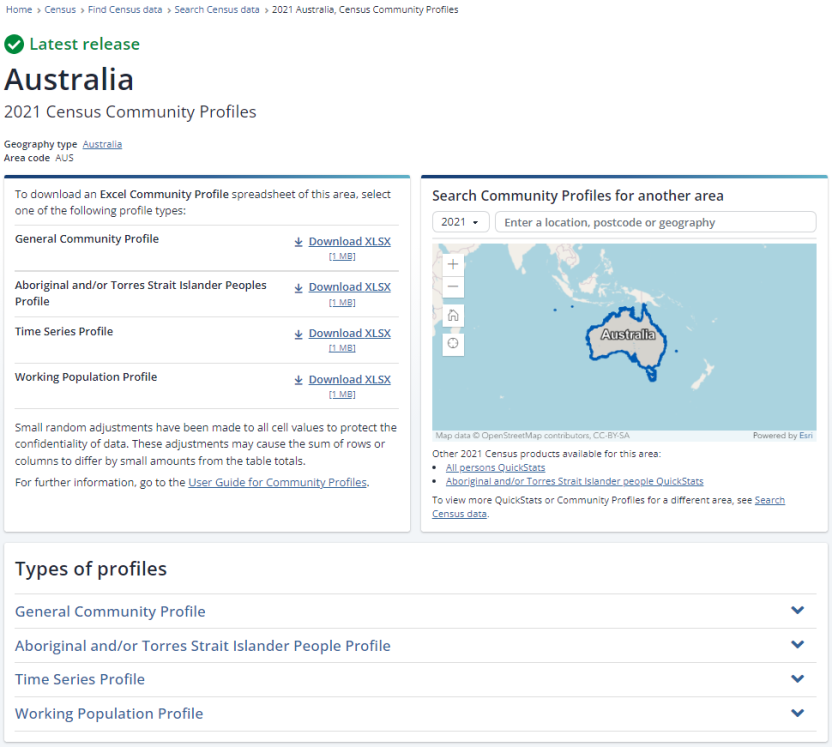Community Profiles
Overview
Community Profiles are tools for researching, planning and analysing geographic areas for a number of social, economic and demographic characteristics. Community Profiles provide a comprehensive statistical picture of an area in Excel spreadsheet, delivering data relating to people, families, and dwellings.
Image

Description
Small random adjustments have been made to all cell values to protect the confidentiality of respondents. These adjustments may cause the sum of rows or columns to differ by small amounts from table totals.
For more information on the confidentiality of data, the 2021 Census Privacy Statement or Introduced random error/perturbation, please refer to Confidentiality.
Where to find Community Profiles
Community Profiles can be found by using the Search Census data tool. This tool is in the Find Census data tile, on the Census homepage.
The Search Census data tool provides you with different ways to find data for a selected area, including Community Profiles and QuickStats. Using one of the options, search by Census year and area to see links to Community Profiles.
For more information about how to use Search Census data, see Search Census data user guide.
Community Profiles templates
Community Profiles templates are blank Community Profiles without data. These templates can be used to understand what data will be released in Community Profiles and the format of the tables and spreadsheets.
To view the Community Profile templates, see Download product templates.
Types of Community Profiles
There are four types of Community Profiles that can be downloaded.
General community profile
The General community profile is based on place of usual residence and contains tables showing the characteristics of persons, families and dwellings in a selected geographic area.
These tables are available for a variety of geographic regions, ranging from national and state level down to Statistical Area Level 2.
Before 2016, the General community profile was referred to as the Basic community profile and Expanded community profile.
General community profiles are available from 1996 onwards.
For more information regarding the release of the 2021 General community profile, its tables and topics, see 2021 Census product release guide.
Aboriginal and Torres Strait Islander people profile
The Aboriginal and Torres Strait Islander people profile is based on place of usual residence and provides characteristics about Aboriginal and Torres Strait Islander people, families and dwellings.
Some tables include comparisons with non-Indigenous people.
The Aboriginal and Torres Strait Islander peoples profile is available for the following geographies:
- Australia
- State/Territory
- Statistical Areas Level 2, 3, 4
- Greater Capital City Statistical Areas
- Indigenous Regions
- Indigenous Areas
- Indigenous Locations
- Remoteness Areas
- Section of State Ranges
- Local Government Areas
The Aboriginal and Torres Strait Islander people profile is available from 2001 onwards.
For more information regarding the release of the 2021 Aboriginal and Torres Strait Islander people profile, its tables and topics, see 2021 Census product release guide.
Time series profile
The 2021 Time series profile presents data from the 2011, 2016 and 2021 Censuses based on the geographical boundaries from the 2021 Census.
Where a data classification has been revised between censuses, data will be output on the classification that has been used in the 2021 Census.
When interpreting the results from different time periods, take care as censuses are based on a point in time. Changes to the Census form design, collection procedures and processing may impact the comparability of data. The data is based on place of usual residence. The Time series profile is available for the following geographies:
- Australia
- State/Territory
- Statistical Areas Level 2, 3, 4
- Greater Capital City Statistical Areas
- Local Government Areas
The Time series profile is available from 2001 onwards.
For more information regarding the release of the 2021 Time series profile, its tables and topics, see 2021 Census product release guide.
Working population profile
The Working population profile contains key Census characteristics of employed persons, based on the person’s place of work. The profile includes data on:
- Hours worked
- Industry of employment
- Occupation
- Qualifications
- Method of travel to work
The Working population profile is available for the following geographies:
- Australia
- State/Territory
- Statistical Areas Level 2, 3, 4
- Greater Capital City Statistical Areas
- Local Government Areas
The Working population profile is available from 2001 onwards.
For more information regarding the release of the 2021 Working population profile, its tables and topics, see 2021 Census product release guide.